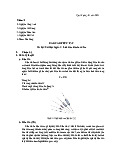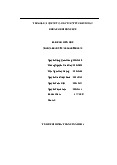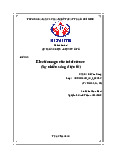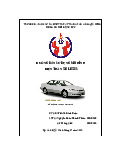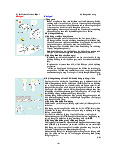



















Preview text:
ĐÁP ÁN TRẮC
NGHIỆM GIỮA KÌ HỆ THỐNG ĐIỆN – ĐIỆN TỬ Ô TÔ
1. As engine rpm increases, the ignition timing must:
A. Secondary winding Technician A says the battery provides electricity by releasing free electron B. Primary winding
C. Electronic control module (ECM) D. Ignition control module
2. As engine rpm increases, the ignition timing must: A. Retard. B. Advance C. Remain the same
D. Remain the same and then retard
3. Which of the following components generates a timing signal for the ignition system? A. ECU B. Crankshaft position sensor C. Rotor D. Ignition coil
4. All of the following components are part of a Distributorless Ignition System (DIS) EXCEPT: A. Spark plug B. Crankshaft position sensor C. Rotor D. Ignition coil pack
5. The HEAT RANGE of a spark plug can be determined by: A. Its part number B. The number of electrodes C. Its length D. Its diameter
6. Which of the following components multiplies battery voltage to create a spark? A. Ignition pickup 1 B. Ignition wires C. Ignition module D. Ignition coil
7. Which of the following can cause changes in Ignition Timing? A. Engine RPM B. Engine Temperature C. Engine Load D. Any of the above
8. If the Crankshaft Position Sensor is not producing a signal, what will happen?
A. Ignition timing will be RETARDED
B. The engine computer will substitute a timing signal
C. There will be no ignition timing
D. Ignition timing will be ADVANCED
9. An eight cylinder engine running at 3000 rpm requires __________ sparks per SECOND. A. 200 B. 300 C. 400 D. 100
10. In an alternator, alternating current is converted to direct current by the: A. Stator B. Rectifier C. Brushes D. Regulator 11. CDI stands for: A. Coil Dual Ignition B. Current Direct Ignition
C. Capacitor Discharged Ignition D. Capacitor Direct Ignition
12. A battery that is overcharged can be due to:
A. loose alternator drive belt B. high speed driving 2
C. high resistance in the field circuit D. defective regulator
13. Why is a thermistor used in an alternator regulator? A. To control minimum current B. To control maximum current C. To control maximum voltage
D. To compensate for temperature change
14. What does EMF stand for? A. Electromagnetic force B. Electromotive force C. Electronic magnetic force D. Electromated force
15. Most vehicles today use the _________ type of ignition system. A. Coil-on-plug B. Distributor C. Breakerless D. Waste spark
16. The type of ignition system in which two cylinders share one coil is called a:
A. Coil-on plug ignition system B. Distributor ignition system
C. Waste spark ignition system D. None of the above
17. In an alternator, which component controls the output? A. Diode B. Cut-out relay C. Current regulator D. Voltage regulator
18. The basic purpose of the overrunning clutch in the starter drive is to:
A. disengage the armature when the engine starts
B. assist the solenoid during cranking.
C. keep the hold-in winding energized during cranking 3
D. pull the starter pinion gear out of mesh
19. A solenoid uses two coils. Their windings are called: A. push-in and hold-out B. push-in and pull-out. C. pull-in and hold-in D. pull-in and push-out
20. The distributor serves the following purposes in the ignition system A. It increase voltage B. both a and b
C. It distributes high tension current to spark plug at correct time D. None of the above
21. In Magneto Ignition system A. No battery is required B. used in high speed engines C. All of the above
D. Engine starting is rather difficult
22. The following is known as ‘Breakerless Ignition system’ A. Magneto Ignition system B. Electronic Ignition system
C. Battery coil ignition system
D. Capacitive discharge Ignition system
23. The discharged lead acid battery has on its plates A. Lead peroxide (PbO ) ₂ B. Spongy lead (Pb) C. Sulphuric acid (H SO ₂ ₄) D. Lead sulphate (PbSO ) ₄
24. The main task of a battery in automobiles is to
A. Supply electricity to the vehicle's electrical system at all times while the engine is running
B. Act as a reservoir or stabilizer of electricity
C. Supply electricity to the alternator
D. Supply a large amount of power to turn the starter motor when the engine is cranking 4
25. During charging the specific gravity of the electrolyte of a lead acid battery A. Remains the same B. Becomes zero C. Decreases D. Increases
26. Which component produces the electricity to charge the battery? A. The Battery B. The Alternator C. The Current Regulator D. The Voltage Regulator
27. Which component uses the most amperage in a vehicle? A. Starter B. Air Conditioning C. Alternator D. Head Lights
28. What part of a car produces the electricity? A. Battery B. Solenoid C. Alternator D. Voltage regulator
29. SV A nói trong đánh lửa trực tiếp bobine đôi, bougie nào ở kỳ nén sẽ có lửa. SV B nói 2
đầu dây cao áp của bôbine phải nối vào 2 bougie của 2 máy song hành. Ai đúng? A. Cả hai đều sai B. Cả hai đều đúng C. SV B D. SV A
30. Các câu dưới về định luật Pashen đều đúng, ngoại trừ:
A. đấu sai cuộn dây sơ cấp sẽ làm tăng điện áp đánh lửa
B. điện áp đánh lửa phụ thuộc vào tỷ lệ hòa khí
C. điện áp đánh lửa tỷ lệ nghịch với chỉ số odometer
D. điện áp đánh lửa tỷ lệ thuận với tỷ số nén . 5
31. Mắc song song 1 điện trở cầu dưới của một cầu phân áp sẽ làm:
A. Tăng điện áp rơi trên cầu dưới
B. Giảm điện áp rơi trên cầu trên
C. Tăng điện áp rơi trên cầu trên D. Cả 3 câu trên sai .
32. Các cảm biến đo nhiệt độ được làm bằng: A. Platin B. Silic C. Chì D. Đồng .
33. Các xung điện áp cao trên xe xuất phát từ các cuộn dây do: A. Dòng giảm B. dòng tăng
C. Từ thông thay đổi đột ngột qua cuộn dây
D. Cả 3 câu trên đều đúng
34. SV A nói: Khả năng tự hạn chế dòng của máy phát xoay chiều là nhờ dòng kích từ lớn.
SV B nói máy phát có khả năng tự hạn chế dòng là nhờ dùng puly đường kính nhỏ. Ai đúng? A. Cả A và B sai B. SV A C. Cả A và B đúng D. SV B
35. Điện áp sau khi chỉnh lưu dao động tuần hòan với chu kỳ A. T B. T/6 C. T/3 D. T/12 . 36. Từ -T/12 A. hyperbol B. hàm cos C. đường thẳng 6 D. hàm sin
37. Điện áp chỉnh lưu là:
A. điện áp tức thời trên 1 pha
B. điện áp trung bình cộng của 2 pha
C. chênh lệch điện áp giữa 2 pha có giá trị tuyệt đối lớn nhất
D. cả 3 câu trên đều sai
38. Dung lượng ắc quy phụ thuộc vào: A. Nồng độ dung dịch B. Số lượng bản cực C. Nhiệt độ dung dịch D. Số ngăn
39. Máy khởi động có đặc tuyến moment có dạng: A. hyperbol B. parabol C. hình sin D. đường thẳng
40. Dung lượng của accu trên xe phụ thuộc vào:
A. công suất phụ tải điện
B. công suất máy khởi động C. công suất máy phát
D. cả ba câu trên đều đúng
41. Trong tiết chế của máy phát loại cuộn kích từ đấu DƯƠNG chờ, nếu giảm điện trở cầu trên R1 sẽ làm:
A. tăng điện áp ở cầu trên
B. giảm điện áp hiệu chỉnh
C. tăng điện áp hiệu chỉnh
D. công suất máy phát giảm .
42. Nếu một diod chỉnh lưu bị đứt:
A. ắc quy không được nạp no
B. điện áp tức thời có lúc sẽ giảm về không
C. điện áp trung bình giảm 7
D. cả ba câu trên đều đúng
43. SV A nói máy khởi động trên các xe Nhật sử dụng hộp giảm tốc kiểu bánh răng hành
tinh. SV B nói máy khởi động xe Đức sử dụng hộp giảm tốc có bánh răng trung gian. Ai đúng? A. SV B B. Cả A và B sai C. Cả A và B đúng D. SV A
44. Khi bắt đầu bật công tắc khởi động:
A. dòng điện trong 2 cuộn hút và giữ ngược chiều nhau
B. cuộn hút mắc song song với motor khởi động
C. cuộn hút được mắc nối tiếp với motor khởi động
D. cuộn hút mắc nối tiếp với cuộn giữ
45. Câu nào dưới đây sai:
A. Dòng điện từ accu vào máy khởi động dao động theo kỳ (thì) làm việc của động cơ.
B. Trong máy khởi động có ly hợp một chiều
C. Máy khởi động sẽ phát điện khi làm việc
D. Dòng vào máy khởi động tỷ lệ thuận với tốc độ quay của nó.
46. SV A nói: dòng vào máy khởi động đạt giá trị cực đại khi bị kẹt. SV B nói dòng vào máy
khởi động thay đổi theo dạng hình sin. Ai đúng? A. SV B B. Cả A và B sai C. SV A D. Cả A và B đúng
47. Nếu đứt Zener trong mạch tiết chế, điện áp của hệ thống cung cấp điện sẽ bằng A. 14.0V
B. Giá trị phụ thuộc vào tốc độ động cơ C. 0.0V D. 5.0V
48. Which of the following type of advancement uses in 4th ignition generation A. Centrifugal advance 8 B. Ignition map C. Vacuum advance D. Complete vacuum control
49. Khi dòng điện qua 1 cuộn dây (relay, bobine, kim phun, solenoid…) bị ngắt đột ngột,
trên cuộn dây sẽ có: A. Xung điện áp cao B. Từ thông C. Điện áp xoay chiều D. Tia lửa điện
50. Dòng khởi động sẽ có giá trị lớn khi: A. Tất cả đều đúng B. Khi đô m ng cơ bị bó cứng C. Khi nước vào xi lanh D. Khi đô m ng cơ lạnh .
51. Máy khởi động trên ô tô sử dụng motor điện tốc độ cao để: A. tăng công suất
B. giảm kích thước động cơ điện C. giảm dòng
D. tăng moment khởi động
52. Dòng điện ngắt Ing trong cuộn sơ cấp phụ thuộc vào: A. nhiệt độ bobine
B. cả 3 câu trên đều đúng
C. độ tự cảm cuộn sơ cấp D. điện trở bôbine
53. Khi động cơ họat động, dòng Ing sẽ: A. lớn ở tốc độ cao
B. không thay đổi theo tốc độ C. ba câu trên đều sai
D. lớn ở tốc độ thấp
54. In 2nd ignition generation, ignition sensor send it signal to: A. Ignition coils 9 B. ECU C. Tachometer D. Igniter
55. Chọn câu đúng. Tốc độ tăng trưởng của dòng sơ cấp:
A. tỷ lệ thuận với độ tự cảm của cuộn sơ cấp
B. phụ thuộc vào tốc độ động cơ
C. phụ thuộc vào điện trở cuộn sơ cấp
D. tỷ lệ nghịch với độ tự cảm cuộn sơ cấp
56. SV A: Kích nổ xảy ra vào kỳ nổ. SV B: Khi ECU điều khiển chống kích nổ, công suất động cơ giảm. A. SV B B. A và B sai C. SV A D. Cả A và B đúng
57. Khi hộp ECU điều khiển chống kích nổ:
A. công suất động cơ tăng
B. nhiệt độ ống thải tăng
C. nghe tiếng gõ động cơ
D. nhiệt độ ống thải giảm
58. Cuộn sơ cấp bôbine có độ tự cảm lớn sẽ làm:
A. cả ba câu trên đều sai
B. lửa yếu ở tốc độ thấp
C. lửa yếu ở tốc độ cao
D. dòng sơ cấp tăng nhanh
59. SV A nói: Kích nổ làm tăng chất ô nhiễm trong pô. SV B nói: Kích nổ xảy ra trước khi
bougie có tia lửa. SV C nói: Khi chống kích nổ, nhiệt độ ống thải sẽ giảm. Ai đúng? A. SV B B. SV A C. Cả A và B sai D. Cả A và B đúng 10
60. SV A nói: Kích nổ làm tăng chất ô nhiễm trong pô. SV B nói: Kích nổ xảy ra trước khi
bougie có tia lửa. SV C nói: Khi chống kích nổ, nhiệt độ ống thải sẽ giảm. Ai đúng? A. Cả A và B sai B. SV B C. SV A D. Cả A và B đúng
61. Phụ tải điện mắc càng xa máy phát thì:
A. Dây dẫn đến nó phải làm bằng nhôm
B. Dây dẫn đến nó tiết diện càng nhỏ.
C. Dây dẫn đến nó phải cách điện tốt
D. Dây dẫn đến nó có tiết diện càng lớn
62. The purpose of neutral diodes is:
A. Reduce load for main diodes
B. Increase alternator’s voltage
C. Increase power at high speed
D. Increase power at low speed
63. What happens if to much loads connected in car electrical system: A. Battery is overcharged B. Battery is discharged C. Diode broken as overloaded D. Alternator burned out
64. When added high power load to car electrical system, we should replace: A. Starter B. Alternator C. Battery D. Regulator
65. Khi khởi động động cơ nhưng không có tia lửa ở đầu cao áp của bobine. Phải kiểm tra
cái gì trước tiên? A. Dây cao áp B. Nắp bộ chia điện
C. Điện áp cấp cho bobine 11 D. Rotor
66. Bộ tiết chế (voltage regulator) kiểm soát trực tiếp: A. Dòng phát ra phụ tải B. Mạch chỉnh lưu
C. Dòng vào cuộn kích từ D. Điện áp chỉnh lưu
67. Điện áp cung cấp cho cảm biến Hall trong các hệ thống điều khiển động cơ là: A. 9V B. 5V C. 12V
D. Cả 3 phương án trên đều đúng
68. Điện áp sinh ra trên cảm biến điện từ lọai nam châm cố định sẽ bằng không (0) khi:
A. Khi răng rotor rời xa răng cuộn dây B. Khi rotor quay chậm.
C. Khi răng rotor đang tiến gần răng cuộn dây
D. Răng rotor trùng răng cuộn dây cảm biến
69. Điện áp sinh ra trên cuộn thứ cấp của bobine khi:
A. khi dòng qua cuộn sơ cấp cực đại
B. Khi transistor công suất ở trạng thái khuếch đại
C. Transistor công suất ngắt
D. Transistor công suất bão hòa
70. Những câu dưới là đúng, ngoại trừ:
A. Diode trung hòa có trong máy phát mắc kiểu tam giác
B. Diode trung hòa giúp tăng công suất máy phát
C. Diode trung hòa có 3 con.
D. Diod trung hòa có trong máy phát đấu kiểu hình sao
71. Dòng phóng của accu càng lớn thì: A. thời gian phóng giảm B. nước bình mau cạn C. thời gian phóng tăng D. mau mòn bản cực 12
72. Alternators have ability to limit their current when operating at: A. low speed B. high speed C. low output current D. high output current .
73. Trên ô tô, accu thường được bố trí ở nơi: A. gần máy phát B. gần máy khởi động C. gần quạt làm mát D. xa hộp cầu chì
74. Máy khởi động trên ô tô sử dụng motor điện tốc độ cao để:
A. Giảm kích thước động cơ điện. B. giảm dòng C. tăng công suất
D. tăng moment khởi động
75. Self discharge rate of battery increases if: A. damaged voltage regulator B. too much electrical loads C. low operating temperature D. high operating temperature
76. Technician A says that the diodes regulate the alternator output voltage. Technician B
says that the field current can be computer controlled. Which technician is correct? A. Both Technicians A and B B. Technician A only C. Neither Technician A nor B D. Technician B only
77. A magnetic field is created in the _________ in an alternator A. Drive-end frame B. Rotor C. Diodes D. Stator 13
78. Technician A says that two diodes are required for each stator winding lead. Technician
B says that diodes change alternating current into direct current. Which technician is correct? A. Neither Technician A nor B B. Technician B only C. Both Technicians A and B D. Technician A only
79. The alternator output current is produced in the _________. A. Brushes B. Stator C. Rotor D. Diodes (rectifier bridge)
80. How much current flows through the alternator brushes?
A. All of the alternator output flows through the brushes B. 2 to 5 A
C. 25 to 35 A, depending on the vehicle D. 10 to 15 A
81. Operating an alternator in a vehicle with a defective battery can harm the _________. A. Brushes B. Rotor C. Voltage regulator D. Diodes (rectifier bridge)
82. Technician A says that a wye-wound stator could has neutral diodes. Technician B says
that an alternator equipped with a delta-wound stator produces more maximum output
than a wye-wound stator. Which technician is correct? A. Neither Technician A nor B B. Technician B only C. Technician A only D. Both Technicians A and B .
83. A magnetic field created in the _____________ is used to induce a voltage in the __________. 14 A. drive-end frame B. diodes; stator C. rotor; stator D. stator; rear housing
84. What is/are used to help control the heat created in the alternator? A. Internal fan B. Any of the above C. Coolant cooled D. External fan
85. An acceptable charging circuit voltage on a 12 volt system is _________. A. 14.9 to 16.1 volts B. 12.6 to 15.6 volts C. 13.5 to 14.5 volts D. 12 to 14 volts
86. Technician A says that the computer can be used to control the output of the alternator
by controlling the field current. Technician B says that voltage regulators control the
alternator output by controlling the field current through the rotor. Which technician is correct? A. Technician B only B. Technician A only C. Both Technicians A and B D. Neither Technician A nor B
87. When the power transistor in igniter is turned off, the voltage appears on: A. Secondary coil B. Both of coils C. None of them D. Primary coil
88. Modern alternators are designed to operate on high speed for: A. Current self-limit B. More output power C. shorter driven belt 15 D. Reduce noise
89. A single wire system is a system with:
A. Car body connected to positive pole of battery
B. Car body connected to negative pole of battery C. Both A&B are false D. Both A&B are true
90. Output current of alternator at the same time goes through: A. Goes only to field coil.
B. Goes through 2 phase windings C. All of diodes of rectifier D. Goes only to battery
91. Điện trở cuộn dây sơ cấp của bobine ngày càng giảm để:
A. Giảm nhiệt trên cuộn dây
B. Giúp động cơ hoạt động tốt ở tốc độ cao
C. Giúp bỏ điện trở phụ
D. Tăng điện áp tự cảm trên cuộn sơ cấp
92. Câu nào dưới đây sai:
A. Tốc độ động cơ tăng thì dòng trung bình qua cuộn kích tăng
B. Tốc độ động cơ tăng thì dòng trung bình qua cuộn kích giảm
C. Tiết chế làm thay đổi dòng điện qua cuộn kích
D. Tiết chế giúp ổn định điện áp máy phát
93. The purpose of diode connected parallel with solenoid: A. increase current B. reduce heat C. reduce EMF D. voltage stability
94. Nếu đấu ngược cực động cơ điện trong máy khởi động trên ô tô thì: A. Ắc quy bị nổ
B. Các cuộn dây sẽ bị cháy
C. Động cơ không đổi chiều quay
D. Động cơ quay theo chiều ngược 16
95. Nếu đấu ngược cực ắc quy trên ô tô thì: A. Cháy máy phát điện B. Nố ắc quy
C. Ắc quy bị nạp ngược D. Cháy cầu chì tổng
96. Trong một ngăn của ắc quy acid chì có 17 bản cực. Câu nào dưới đây đúng? A. 8 dương, 9 âm B. 9 dương, 8 âm C. Cả A, B đều đúng D. Cả A, B đều sai
97. Một bộ tiết chế có điện áp điều chỉnh theo mùa. Câu nào dưới đây đúng?
A. Tất cả các câu trên đều sai.
B. Vào mùa hè tiết chế có điện trở cầu dưới nhỏ
C. Mùa đông điện áp hiệu chỉnh cao hơn
D. Mùa hè điện áp hiệu chỉnh cao hơn
98. The drive shaft in distributor is rotated at ___ the engine speed in four stroke engine A. half B. double C. one and half times D. equal to
99. The breakdown voltage required to jump over the gap of spark plug depens on:
A. Temperature of side electrode B. Intake air temperature C. Compression ratio D. Manifold pressure .
100. What following statements are true?
A. “Hot” spark plug has higher temperature of central electrode
B. To limit the current of primary coil the ECU change pulse width
C. Coils on plug use for conventional ignition system
D. High electrode gap belongs to cold type of spark plug. . 17 Câu hỏi thêm :
1. All of the following components are common to all ignition systems except: distributor
2. Which of the following does the ignition system use to convert relatively low-
voltage and high-current flow into very high-voltage and very low-current flow? Induction coil
3. Which of the following systems has the fewest parts, which reduces failures and
maintenance the most? coil on plug
4. Tech A says that contact breaker points are a mechanical switch that opens and
closes once for every ignition spark that is created. Tech B says that contact
breaker points send high voltage directly from the points to the spark plugs. Who is correct? tech a
5. In electronically triggered ignition systems, the spark timing is engineered into
the design of the engine and is not adjustable. Which component measures
engine speed? crankshaft postion
6. Tech A says that a Hall-effect switch uses light to turn a circuit on and off. Tech
B says that waste spark systems don't need distributors. Who is correct? tech b
7. Which of these usually increases primarily because of the growing gap of the
spark plug as it wears over time? required voltage
8. Tech A says that as engines gain miles, the spark plug gap increases, which
raises the ignition system's available voltage. Tech B says that misfire occurs
when required voltage is higher than available voltage. Who is correct? tech b
9. Which of the following ignition switch positions unlocks the steering column
but does not enable any electrical systems or disable the engine immobilizer or theft-deterrent system? off
10. Tech A says that coil-on-plug ignition systems use one coil to fire two cylinders.
Tech B says that you should twist spark plug boots before removing them. Who is correct? tech b
11. Tech A says that the positive side of the coil primary circuit is typically
switched by the ignition module. Tech B says that on two-wire COP coils, the
coil is switched by an external ignition module or the PCM. Who is correct? B 18
12. The type of ignition system in which two cylinders share one coil is called a: waste spark ignition system
13. Most vehicles today use the ______ type of ignition system. coil on plug
14. The amount of voltage needed to initially get the spark to jump the spark plug
gap is called the: required voltage
15. Tech A says that as engine RPM increases, spark timing generally increases.
Tech B says that as engine load increases, spark timing generally decreases. Who is correct? Both
16. Tech A says that the ignition system will maintain spark at the spark plug for
approximately 23 degrees of crankshaft rotation. Tech B says that the duration
of spark in the spark plug only lasts 2 to 3 degrees of crankshaft rotation. Who is correct? tech b
17. As the high voltage pushes current across the spark plug electrodes, the air fuel
mixture is ignited, causing very high pressure, which in turn pushes the piston down on the power stroke. True
18. Tech A states that when the driver turns the key to the Start position, an
electrical connection is made between the vehicle battery and the secondary
winding of the ignition coil. Tech B states that as the engine is cranked, a
switching circuit turns the primary ignition coil circuit on and off. Who is correct? tech b
19. Tech A says that as engine rpm increases, spark timing generally increases. Tech
B says that as engine load increases, spark timing generally decreases. Who is correct? Both
20. As engine rpm increases, the ignition timing must: advance
21. The voltage regulator controls the current through: The generator brushes, The rotor, The generator field
22. The ignition system must also be able to advance or retard the timing of the
spark, based on engine conditions such as ________, speed, and driver input. Load 19
23. Although there are several types of ignition systems, the common components
include the spark plugs, the ______, and a device for triggering the ignition coil. ignition coil
24. On an engine with a separate fuel injector for each cylinder, cylinder power
balance tests may involve: disconnecting the fuel injector wire connection at
each individual injector one at a time.
25. If there is a slight drag between the gapping tool gauge and the spark plug
electrodes as the gauge is installed and removed, it means: the gap of the spark plug is correct
26. Finding breakdowns in coil insulation requires the coil to be activated and the
available voltage to be measured on a(n) ________ and compared to specifications. Oscilloscope
27. How even should the cranking compression be between the lowest and highest
cylinder readings on an engine without mechanical problems? within 10% to 15%
28. When testing intake manifold vacuum, a low steady reading at idle is likely to
be caused by: late ignition timing or valve timing
29. The pattern in which a lab scope shows all the cylinders firing in sequence is called the: parade pattern
30. Many oscilloscopes have the ability to stack each spark plug's ignition pattern
vertically, which is called ________. Raster
31. When testing intake manifold vacuum, the gauge needle oscillates back and
forth rapidly, which generally indicates: mechanical condition such as a burned or bent valve
32. Tech A says that a defective crankshaft or camshaft position sensor can prevent
an engine from starting. Tech B says that if a diagnostic trouble code (DTC)
indicates a problem with the crankshaft or camshaft position sensor, you will
always have to replace the sensor. Who is correct? A
33. On an engine with a separate coil for each spark plug, performing a power
balance test may involve: disconnecting each individual coil one at a time to disable one cylinder at a time 20
